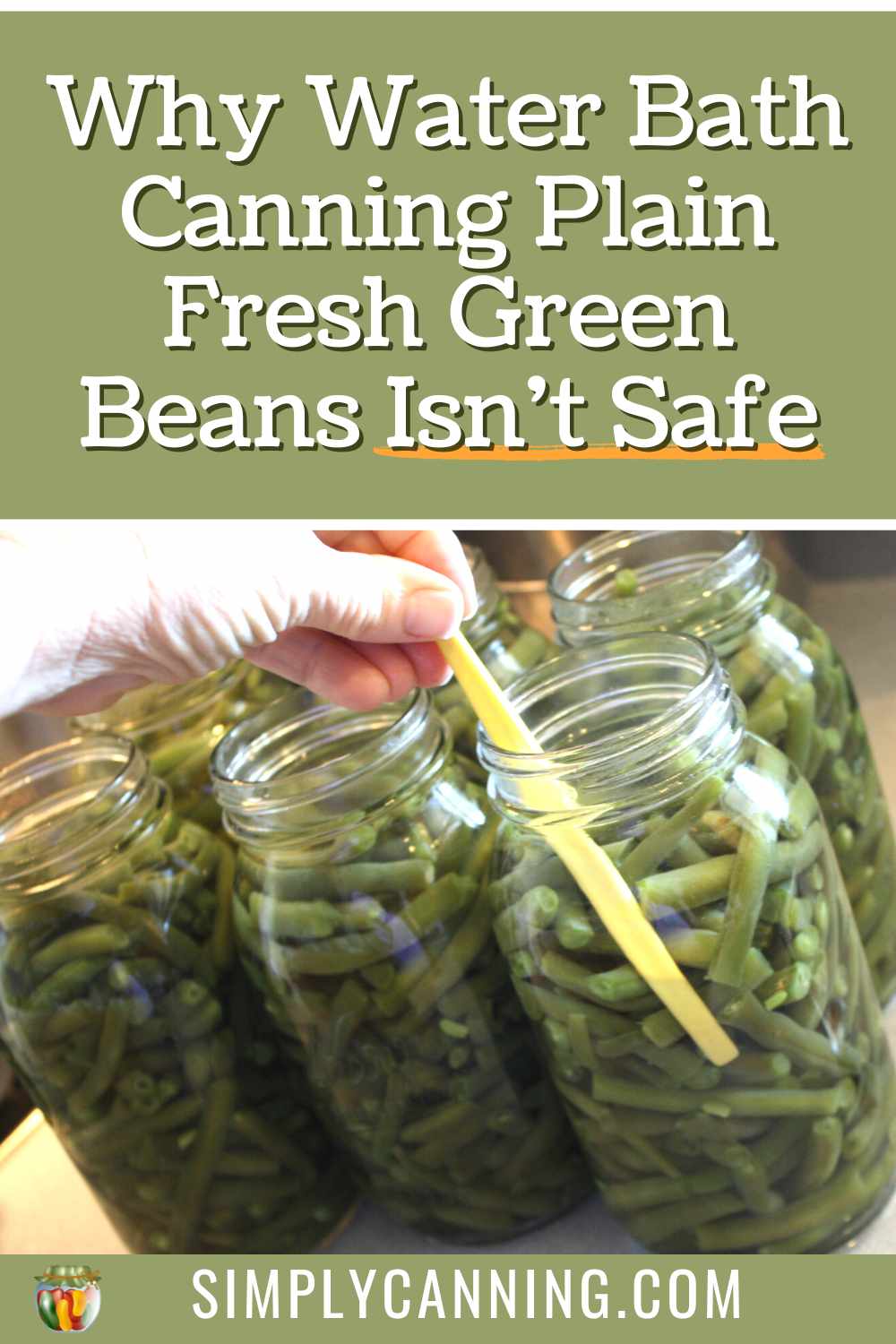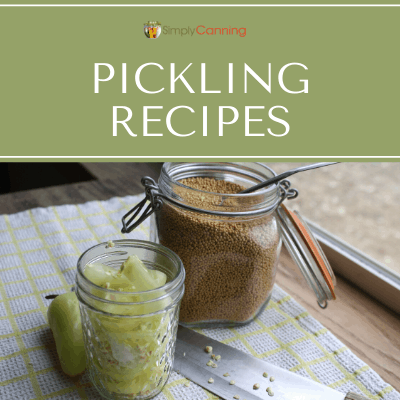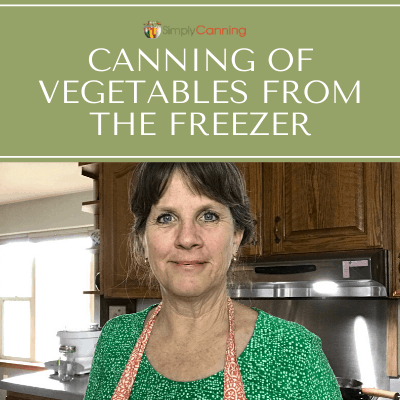Is water bath canning green beans safe?
This page may contain affiliate links. More Information.
In this article, we’ll discuss why water bath canning plain green beans is not recommended. But… don’t click away just yet. We’ll also discuss how your green beans CAN be preserved when you don’t have a pressure canner. So all is good!
Canning green beans is a popular topic, and many people wonder if it’s possible to water bath can green beans. Pressure Canning is required in most instances. But for those of you who don’t have a pressure canner you can still achieve your goal of preserving green beans.
The basic steps to canning plain fresh green beans are: Wash and snap to prepare. They can be successfully canned with either raw pack or hot pack. Pack green beans into canning jars. Add salt to each jar and pack the green beans adding hot water to 1 inch headspace. Add lids, placed filled jars in a pressure canner and process according to pressure canning instruction. Which is where the question comes in. Can I process fresh green beans in a water bath?

Check these table of contents for specific areas of information. If you want to skip right to the recipes where you don’t need a pressure canner just click on down.
Water Bath Canning Green Beans: You’ve got a Choice
When it comes to home canned green beans, it’s important to understand the potential risks associated with water bath canning. Green beans are considered a low acid food, which makes them particularly vulnerable to the growth of toxins and harmful bacteria, including Clostridium botulinum—the culprit behind botulism.
I absolutely am not trying to cause fear. You really don’t need to be afraid of botulism because it’s easy to avoid.
For more on what is botulism as related to home canning? and why I’m not afraid.
It’s not hard to avoid botulism. The spores can be destroyed at high temperatures. Pressure canners are designed to reach and maintain temperatures of 240-250°F (116-121°C), which effectively kills the spores. On the other hand, water bath canners and steam canners can only reach temperatures of around 212°F (100°C), which is not sufficient to eliminate botulism spores.
A water bath simply does not have the ability to get any low acid vegetable to the temperatures needed. Even if you boil water for hours and hours.
Pressure canning is essential. Unlike water bath canning, pressure canning utilizes steam under pressure to reach temperatures between 240-250°F (116-121°C). These higher temperatures are crucial for destroying the spores of Clostridium botulinum and ensuring the safety of canned green beans.
I’m terrified of my pressure canner!
I know so many people who are afraid of a pressure canner. It can be intimidating when you first start. If you are someone who has a pressure canner that has been sitting un-used (sometimes for years!). You are not alone.
But I’d suggest being more afraid of making someone sick. Botulism is not hard to avoid, and you CAN get used to pressure canners. Really I know you can!
I’ve got a workshop here to encourage you. Check out Pressure Canning Confidence.
I don’t trust the recommendations. They just don’t want us saving food.
This is a subject I’ve considered long and hard. I do understand that distrust. I’m not one to blindly follow and I’m pretty disgusted with the way things are going lately. (nuff said on that!)
You’ll have to make your own decision on following guidelines or not. It’s always good to approach information critically, it’s essential to weigh the benefits of following suggested guidelines, vs the risks of doing your own thing.
It’s not hard to be extra safe. I’ve decided that the precautions at the National Center for Home Food Preservation are not hard to follow, and I love peace of mind. :).
Home canning testing was going on for a very long time. Pressure canners have actually been around for a very long time too. (Longer than you might realize)
I go over more in this article on Canning Safety; Are we On Overkill?
The Good news! How to Preserve Green Beans Without a Pressure Canner
Pickling green beans with a water bath, dehydrating them, or freezing them are all viable options for extending their shelf life while ensuring safety.
Pickling green beans
Have you ever had dilly beans? Oh goodness are they good! Because of the added acid, usually in the form of vinegar they are perfect for those of you win no pressure canner.
They have a tangy crisp flavor, perfect for snacking. I use them basically like any dill pickle. You can also add them to salads for a bit of zing. For detailed instructions on pickling green beans, check out my dilly beans recipe. No pressure canner needed.
Dehydrating green beans
Dehydrating es a fantastic method for preserving their flavors and nutrients while extending their shelf life. To learn more about the process of dehydrating green beans and how to enjoy them check out our article on How to Dry Green Beans
Freezing green beans
is a convenient and simple way to preserve their freshness and vibrant colors. Although it doesn’t have the benefit of shelf stable storage, it is better than risking getting sick. Here is a step-by-step guide with best practices for freezing green beans.
Freeze drying green beans
Freeze drying is now available to the home food preserver. It is a big investment up front but is a unique preservation technique. Like dehydrating, it involves removing moisture from the beans while preserving their taste, texture, and nutrients. Check out how to freeze dry foods here.
Canning Green Beans (with a pressure canner)
For those who’ve been convinced, and want to follow the pressure canning steps. Check this article with step by step instruction on how to can green beans.
Frequently Asked Questions
Unfortunately, water bath canning plain green beans is not recommended. Given the low acidity of green beans, they need the sustained high temperatures achievable only through pressure canning to prevent the growth of harmful bacteria and reduce the risk of botulism.
A water bath simply does not have the ability to get any low acid vegetable to the temperatures needed. Even if you boil for hours and hours.
There are no vegetables can be canned plain with a water bath. However! Many vegetables can be canned in it’s pickled version. Try pickled carrots, beans, corn, beets and more.
If you really want to water bath green beans, you can take that chance. No one is going to stop you. It’s your kitchen after all. You’ll find many recipes online with instruction. You have to decide for yourself the risks you want to take.
It’s crucial to understand the risks involved. Water bath canning does not provide the necessary temperatures to eliminate the harmful bacteria that may cause botulism. If you want to can green beans, it’s strongly advised to invest in a pressure canner to protect against the risk of botulism. Or you can simply pickle them!
Canning green beans in an Instant Pot is not recommended or safe. The Instant Pot is primarily designed for cooking and pressure cooking, but it does not meet the necessary requirements for canning. I’ve got more here on canning in general with an instant pot.
What others have to say…
I’ve gotten some great messages from others regarding this topic. I’m going to include a comment here from a reader who is an “ARNP-C (Family Nurse Practitioner-Certified)”
Sharon, thanks for stressing the pressure canning method for canning green beans. There is no other way to can green beans, not withstanding what all of our grandmas did.
I worked in the operating room for 22 years as a Registered Nurse. Our preferred method of sterilizing operative instruments was by steam under pressure. U can reach a much higher sustained temperature with steam under pressure. This method kills resistant micro organisms and spores, fungus, yeast, viral and bacterial micro organisms.
You just can’t kill ALL of those organisms by submerging in boiling water. Some of the most nasty organisms form spores around their cell so they can survive without a host for a long time.
Botulism is the condition when a nasty organism isn’t killed by boiling water and comes alive again in a person’s gut after it is unknowingly ingested.
Having said that, PLEASE, everyone, there should be no hesitation when it come to using a pressure canner for non-acid foods! The initial investment in a pressure canner is totally, totally worth it! Thanks.
Pin This for Later!








I have canned green beans my whole life. Quart jars need to stay in the water bath for—– Many don’t want to process them that long.
Unfortunately it doesn’t matter how long you process you’ll still not get to the temperatures that you can get in a pressure canner.
Sharon I understand the thinking from both sides on the waterbath verses pressure canning of vegetables what it comes down to personal preference and risk assessment. It’s also not safe to eat a baked potato thats been wrapped in foil or consume oil infused with garlic these also have been linked to botulism poisioning, But people do everyday. My point being, when I was a kid I remember my grandmother and mother water bath canning everything, neither owned a pressure canner. My grandmother would can on an open fire in a large black cast iron rendering pot. Or on a… Read more »
Dave, like you said it is a personal decision. I stand by my recommendation to use a pressure canner where appropriate. If you can’t use your stove, do you have an area outside where you could set up? It would need to be sheltered from the wind. Get an outdoor burner. I use a camp chef stove for canning.
I have been canning green beans in a waterbath canner for 45 years. My family and family friends have been doing it for decades, long before I was even around. Adding a pickling solution instead of just water is the key. They come out crisp, delicious and safe.
Oh yes pickled green beans are fine if you are using an appropriate pickling solution. For anyone who wants to try it you can find a pickled green beans recipe here…
Thank you for this. I started my canning journey many years ago with a class. The very first slide they showed was a church with multiple caskets from the botulism deaths of a family who had eaten waterbath canned green beans. (I grew up eating canned green beans from my grandmother who I’m pretty sure water bath canned only) They weren’t my favorite to begin with, but since then I have never had a canned green bean 🙂 I freeze, or now freeze-dry my own harvests. I found these when searching for the image. My guess is that this happens… Read more »
I make pickled green bean water bath with a recipe out of the ball canning book. Is the article talking about pickled green bean too?
Thank you
No, pickled products can be processed safely in a water bath canner because of the added vinegar, which adds acid and makes it safe. https://www.simplycanning.com/dilly-beans/
-Rachel (Sharon’s assistant)
I just water bathed 24 pints of green beans (last night). Now I’m reading that this is wrong and I’m nervous. Are they a loss or can I put them in my pressure canner today so I don’t waste them?? Thanks!
If it’s been less than 24 hours, you can place the food in the fridge or freezer, or you could reprocess in jars (using the exact same steps as if the beans were fresh). However, I think they would be mushy after being processed again, so I’d suggest freezing or refrigerating them instead.
-Rachel (Sharon’s assistant)
Thanks – I am in the process of pressure canning – fingers crossed they aren’t mushy. Sad thing – I typically pressure can them, but I had a ‘wise ole owl’ of older generation tell me that they water bathed them for years. I decided to try… never again… BTW – I did water bath a batch of green beans in mid-July – they are already spoiled – cloudy – smelled really bad – popped their lids. So – I pitched everything I did in July… sad lesson learned (so much work wasted). Another question – beets – I roasted… Read more »
Sadly yes the risk is the same. Any meat or vegetable must be pressure canned. Also since your beans are already cooked be sure you use the hot pack method for your second pressuring… (is that a word?) You’ll need to heat them up repack your jars and then proceed.
And in case you are wondering… don’t try to reprocess your waterbath beets. 🙁 Sadly I would not eat them either. I hate being the bearer of bad news.
And to clarify, IF you do want to reprocess…you’ll need to remove the beans from the jars, reheat, and pack the beans into the jars again using the hot pack instructions. Please let me know if that isn’t clear. 🙂
-Rachel (Sharon’s assistant)
Hi Sharon,
My daughter water bath canned some green beans 6 days ago, not knowing they should be pressure canned. Can we eat them now or attempt to pressure can them? Or do they need thrown out?
Since it’s been 6 days already at room temp (not refrigerated, I assume), they should be thrown away.
-Rachel (Sharon’s assistant)
Really? Not safe? I have eaten beans canned by water bath method all.ky life and have never gotten sick from them. Nor have I ever met anyone who has.
Hi, John! You can read more of Sharon’s thoughts and perspectives on this subject here: https://www.simplycanning.com/canning-safety-overkill/ There are no canning police, as she likes to say, however, so you have to make your own decisions.
-Rachel (Sharon’s assistant)
Actually! That’s they way it was always done by my ancestors. I do not recall anyone ill or dying from it.
Hi Stewart, I’ll refer you to the same article.:) Canning Safety Overkill? In that post I discuss the statistics of food-born botulism. I’m glad you don’t know anyone who has become ill from this practice. I still would not take that extra risk. Processing with a pressure canner is very easy.
If I add a teaspoon of lemon juice will that add acid
You can’t just add acid to vegetables to make them safe for water bath, because it would have to be at a certain level (and only a tested recipe would be able to tell you that) – they need to be pressure canned.
-Rachel (Sharon’s assistant)